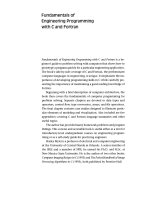Programming with methods and classes
Bạn đang xem bản rút gọn của tài liệu. Xem và tải ngay bản đầy đủ của tài liệu tại đây (131.08 KB, 47 trang )
Programming with
methods and classes
Copyright © The McGraw-Hill Companies, Inc. Permission required for reproduction or display.
Methods
•
Instance method
Operates on a object (i.e., and instance of the
class)
–
String s = new String("Help every cow reach its "
+ "potential!");
int n = s.length();
•
Instance method
Class method
– Service provided by a class and it is not associated with a particular
object
String t = String.valueOf(n);
Class method
Data fields
•
Instance variable and instance constants
– Attribute of a particular object
– Usually a variable
Point p = new Point(5, 5);
int px = p.x;
•
Instance variable
Class variable and constants
– Collective information that is not specific to individual objects of the
class
– Usually a constant
Color favoriteColor = Color.MAGENTA;
double favoriteNumber = MATH.PI MATH.E;
Class constants
Task – Conversion.java
•
Support conversion between English and metric values
–
1 gallon = 3.785411784 liters
– 1 mile = 1.609344 kilometers
– d degrees Fahrenheit = (d – 32)/1.8 degrees Celsius
– 1 ounce (avdp) = 28.349523125 grams
– 1 acre = 0.0015625 square miles = 0.40468564 hectares
Conversion Implementation
public class Conversion {
// conversion equivalencies
private static final
double
LITERS_PER_GALLON =
3.785411784;
private static final double
KILOMETERS_PER_MILE = 1.609344;
private static final double
GRAMS_PER_OUNCE = 28.349523125;
private static final double
HECTARES_PER_ACRE = 0.40468564;
Conversion implementation
Modifier public indicates other classes can use
themethod
Modifier static indicates themethod is a class
method
public static double gallonsToLiters(double g) {
return gallons * LITERS_PER_GALLON;
}
Observe there is no referencein themethod to an attribute of an
implicit Conversion object (i.e., a "this" object). This absence is a class
method requirement. Class methods areinvoked without respect to
anyparticular object
Conversion Implementation
// temperature conversions methods
public static double fahrenheitToCelsius(double f) {
return (f 32) / 1.8;
}
public static double celsiusToFahrenheit(double c) {
return 1.8 * c + 32;
}
// length conversions methods
public static double kilometersToMiles(double km) {
return km / KILOMETERS_PER_MILE;
}
Conversion Implementation
// mass conversions methods
public static double litersToGallons(double liters) {
return liters / LITERS_PER_GALLON;
}
public static double gallonsToLiters(double gallons) {
return gallons * LITERS_PER_GALLON;
}
public static double gramsToOunces(double grams) {
return grams / GRAMS_PER_OUNCE;
}
public static double ouncesToGrams(double ounces) {
return ounces * GRAMS_PER_OUNCE;
}
Conversion Implementation
// area conversions methods
public static double hectaresToAcres(double hectares) {
return hectares / HECTARES_PER_ACRE;
}
public static double acresToHectares(double acres) {
return acres * HECTARES_PER_ACRE;
}
}
Conversion use
Consider
Scanner stdin = new Scanner(System.in);
System.out.print("Enter number of gallons: ");
double liters = stdin.nextDouble();
double gallons =
Conversion.litersToGallons(liters);
System.out.println(gallons + " gallons = "
+ liters
+ " liters");
Produces
A preferred Conversion use
Part of java.text
NumberFormat style = NumberFormat.getNumberInstance();
style.setMaximumFractionDigits(2);
style.setMinimumFractionDigits(2);
System.out.println(gallons + " gallons = "
+ style.format(liters) + " liters");
Rounds
3.0 gallons = 11.36 gallons
Method invocations
•
Actual parameters provide information that is otherwise unavailable
double gallons = Conversion.litersToGallons(liters);
•
When a method is invoked
– Java sets aside activation record
memory for that
particular invocation
• Activation record stores, among other things, the values of the
formal parameters and local variables
– Formal parameters initialized using the actual parameters
• After initialization, the actual parameters and formal parameters
are independent of each other
– Flow of control is transferred temporarily to that method
Value parameter passing demonstration
public class Demo {
public static double add(double x, double y) {
double result = x + y;
return result;
}
public static double multiply(double x, double y) {
x = x * y;
return x;
}
public static void main(String[] args) {
double a = 8;
double b = 11;
double sum = add(a, b);
System.out.println(a + " + " + b + " = "
+ sum);
double product = multiply(a, b); System.out.println(a +
" * " + b + " = " + product);
}
Value parameter passing demonstration
multiply() does not
change the actual
parameter a
Demo.java walkthrough
double sum = add(a, b);
Initial values of formal parameters
come fromthe actual parameters
public static double add(double x, double y) {
double result = x + y
return result;
}
main()
add()
a
a
b
b
11.0
sum
sum
19.0
product
product
8.0
8.0
11.0
x
y
y
8.0
11.0
result
result
19.0
8.0
11.0
Demo.java walkthrough
double multiply = multiply(a, b);
Initial values of formal parameters
come fromthe actual parameters
public static double multiply(double x, double y)
{
x = x + y
return
}
x;
main()
multiply()
a
a
b
b
8.0
11.0
11.0
sum
19.0
sum 19.0
product
product
8.0
88.0
x
y
y
88.0
8.0
11.0
11.0
PassingReferences.java
public class PassingReferences {
public static void f(Point v) {
v = new Point(0, 0);
}
public static void g(Point v) {
v.setLocation(0, 0);
}
public static void main(String[] args) {
Point p = new Point(10, 10);
System.out.println(p);
f(p);
System.out.println(p);
g(p);
System.out.println(p);
}
}
PassingReferences.java run
g() can change the
attributes of the
object to which p
refers
PassingReferences.java
public static void main(String[] args) {
Point p = new Point(10, 10);
System.out.println(p);
f(p);
main()
main()
Pooiin
p
yy::
1100
f()
ntt
x::
1100
v
Method main()'s variable p and method f()'s formal
parameter v have the same value, which is a
reference to an object representing location (10, 10)
java.awt.Point[x=10,y=10]
PassingReferences.java
public static void f(Point v) {
v = new Point(0, 0);
}
main()
p
f()
PPooiinnt
t
yy::
1100
xx::
1100
Point
v
y:
0
x:
0
PassingReferences.java
public static void main(String[] args) {
Point p = new Point(10, 10);
System.out.println(p);
f(p);
main()
main()
PPooi
p
y::
1100
g()
v
System.out.println(p);
g(p);
java.awt.Point[x=10,y=10]
java.awt.Point[x=10,y=10]
inntt xx::
1100
Method main()'s
variablep and method
g()'s formal parameter
vhavethesame value,
which is a reference to
an object representing
location (10, 10)
PassingReferences.java
public static void g(Point v) {
v.setLocation(0, 0);
}
main()
PPPooo
p
yy::
100
g()
v
iiinnn
ttt
xx::
100
Method main()'s
variablep and method
g()'s formal parameter
vhavethesame value,
which is a reference to
an object representing
location (10, 10)
PassingReferences.java
public static void main(String[] args) {
Point p = new Point(10, 10);
System.out.println(p);
f(p);
main()
Point
p
System.out.println(p);
g(p);
System.out.println(p);
java.awt.Point[x=10,y=10]
java.awt.Point[x=10,y=10]
y: 0
x: 0
What’s wrong?
class Scope {
public static void f(int a) {
int b = 1;
//
System.out.println(a); //
a = b;
//
System.out.println(a); //
}
local definition
print 10
update a
print 1
public static void main(String[] args) {
int i = 10;
// local definition
f(i);
// invoking f() with i as parameter
System.out.println(a);
System.out.println(b);
}
}
Variables a and b do not exist in the scope of method main()
Blocks and scope rules
•
A block is a list of statements nested within braces
– A method body is a block
– A block can be placed anywhere a statement would be legal
• A block contained within another block is a nested block
•
A formal parameter is considered to be defined at the beginning of the method
body
•
A local variable can be used only in a statement or nested blocks that occurs after
its definition
•
An identifier name can be reused as long as the blocks containing the duplicate
declarations are not nested one within the other
•
Name reuse within a method is permitted as long as the reuse occurs in distinct
blocks









